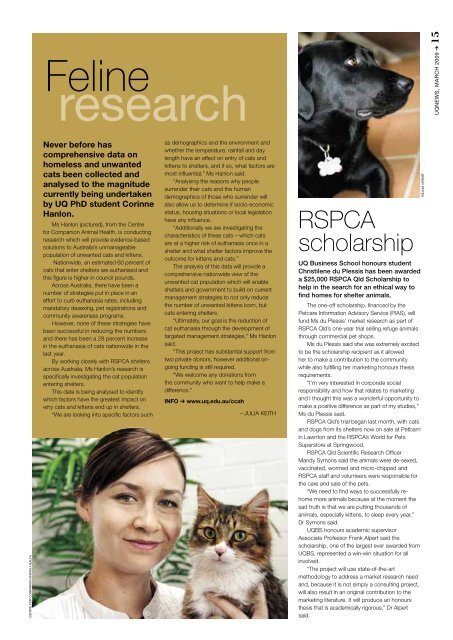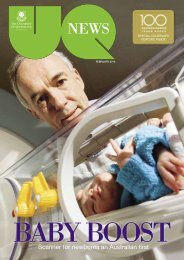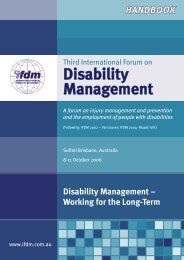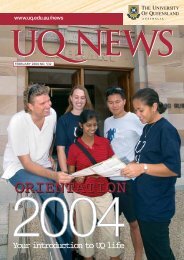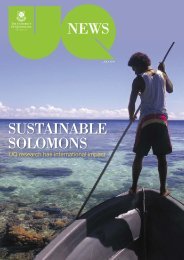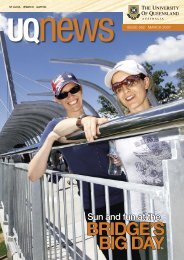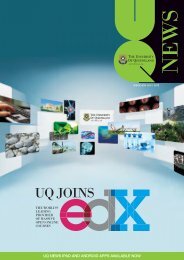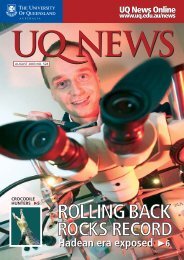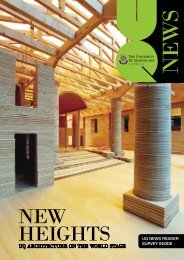Issue 581 (March 2009) - Office of Marketing and Communications
Issue 581 (March 2009) - Office of Marketing and Communications
Issue 581 (March 2009) - Office of Marketing and Communications
- No tags were found...
You also want an ePaper? Increase the reach of your titles
YUMPU automatically turns print PDFs into web optimized ePapers that Google loves.
FelineresearchUQNEWS, MARCH <strong>2009</strong> ➔ 15CENTRE FOR COMPANION ANIMAL HEALTHNever before hascomprehensive data onhomeless <strong>and</strong> unwantedcats been collected <strong>and</strong>analysed to the magnitudecurrently being undertakenby UQ PhD student CorinneHanlon.Ms Hanlon (pictured), from the Centrefor Companion Animal Health, is conductingresearch which will provide evidence-basedsolutions to Australia’s unmanageablepopulation <strong>of</strong> unwanted cats <strong>and</strong> kittens.Nationwide, an estimated 60 percent <strong>of</strong>cats that enter shelters are euthanised <strong>and</strong>this figure is higher in council pounds.Across Australia, there have been anumber <strong>of</strong> strategies put in place in aneffort to curb euthanasia rates, includingm<strong>and</strong>atory desexing, pet registrations <strong>and</strong>community awareness programs.However, none <strong>of</strong> these strategies havebeen successful in reducing the numbers<strong>and</strong> there has been a 28 percent increasein the euthanasia <strong>of</strong> cats nationwide in thelast year.By working closely with RSPCA sheltersacross Australia, Ms Hanlon’s research isspecifically investigating the cat populationentering shelters.This data is being analysed to identifywhich factors have the greatest impact onwhy cats <strong>and</strong> kittens end up in shelters.“We are looking into specific factors suchas demographics <strong>and</strong> the environment <strong>and</strong>whether the temperature, rainfall <strong>and</strong> daylength have an effect on entry <strong>of</strong> cats <strong>and</strong>kittens to shelters, <strong>and</strong> if so, what factors aremost influential,” Ms Hanlon said.“Analysing the reasons why peoplesurrender their cats <strong>and</strong> the hum<strong>and</strong>emographics <strong>of</strong> those who surrender willalso allow us to determine if socio-economicstatus, housing situations or local legislationhave any influence.“Additionally we are investigating thecharacteristics <strong>of</strong> these cats – which catsare at a higher risk <strong>of</strong> euthanasia once in ashelter <strong>and</strong> what shelter factors improve theoutcome for kittens <strong>and</strong> cats.”The analysis <strong>of</strong> this data will provide acomprehensive nationwide view <strong>of</strong> theunwanted cat population which will enableshelters <strong>and</strong> government to build on currentmanagement strategies to not only reducethe number <strong>of</strong> unwanted kittens born, butcats entering shelters.“Ultimately, our goal is the reduction <strong>of</strong>cat euthanasia through the development <strong>of</strong>targeted management strategies,” Ms Hanlonsaid.“This project has substantial support fromtwo private donors, however additional ongoingfunding is still required.“We welcome any donations fromthe community who want to help make adifference.”INFO ➔ www.uq.edu.au/ccah– JULIA KEITHRSPCAscholarshipUQ Business School honours studentChristilene du Plessis has been awardeda $25,000 RSPCA Qld Scholarship tohelp in the search for an ethical way t<strong>of</strong>ind homes for shelter animals.The one-<strong>of</strong>f scholarship, financed by thePetcare Information Advisory Service (PIAS), willfund Ms du Plessis’ market research as part <strong>of</strong>RSPCA Qld’s one-year trial selling refuge animalsthrough commercial pet shops.Ms du Plessis said she was extremely excitedto be the scholarship recipient as it allowedher to make a contribution to the communitywhile also fulfilling her marketing honours thesisrequirements.“I’m very interested in corporate socialresponsibility <strong>and</strong> how that relates to marketing<strong>and</strong> I thought this was a wonderful opportunity tomake a positive difference as part <strong>of</strong> my studies,”Ms du Plessis said.RSPCA Qld’s trial began last month, with cats<strong>and</strong> dogs from its shelters now on sale at Petbarnin Lawnton <strong>and</strong> the RSPCA’s World for PetsSuperstore at Springwood.RSPCA Qld Scientific Research <strong>Office</strong>rM<strong>and</strong>y Symons said the animals were de-sexed,vaccinated, wormed <strong>and</strong> micro-chipped <strong>and</strong>RSPCA staff <strong>and</strong> volunteers were responsible forthe care <strong>and</strong> sale <strong>of</strong> the pets.“We need to find ways to successfully rehomemore animals because at the moment thesad truth is that we are putting thous<strong>and</strong>s <strong>of</strong>animals, especially kittens, to sleep every year,”Dr Symons said.UQBS honours academic supervisorAssociate Pr<strong>of</strong>essor Frank Alpert said thescholarship, one <strong>of</strong> the largest ever awarded fromUQBS, represented a win-win situation for allinvolved.“The project will use state-<strong>of</strong>-the-artmethodology to address a market research need<strong>and</strong>, because it is not simply a consulting project,will also result in an original contribution to themarketing literature. It will produce an honoursthesis that is academically rigorous,” Dr Alpertsaid.JEREMY PATTEN


